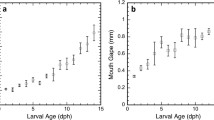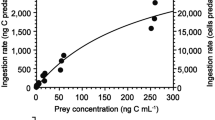Summary
(1) Ingestion rates by adult female and juvenile Acanthocyclops robustus on a number of prey types were measured at a prey concentration of 100/l in experimental volumes of 300–400 ml. (2) For the adult predator, Synchaeta pectinata was most vulnerable (22.3, standard error 1.4, prey ingested per predator per day) as compared to Brachiomus calyciflorus, Brachionus diversicornis, Keratella cochlearis (two morphs), Asplanchna priodonta, Polyarthra major, Synchaeta kitina, Pompholyx sulcata, Daphnia spec., and Bosmina longirostris. For these latter prey, the lowest ingestion rate was on one morph of K. cochlearis and the highest on A. priodonta, being, respectively, 1.0, SE 0.5, and 11.3, SE 1.0, prey per predator per day. (3) With regard to the juvenile predator (mostly copepodite stages I, II and III), ingestion rates on K. cochlearis and P. sulcata were low (respectively 1.2, SE 0.7, and 0.3, SE 0.1, prey per predator per day) but quite high on S. kitina (5.7, SE 0.6). (4) In addition, the effect of increasing prey concentration on the ingestion rate (functional response) by the adult female predator was examined for B. calyciflorus, K. cochlearis, S. pectinata, S. kitina and Daphnia spec.. Increases in ingestion rate with prey density were minimal for B. calyciflorus and K. cochlearis, greater for Daphnia spec., still greater for S. pectinata and of greatest magnitude for S. kitina. (5) The reasons for these results are discussed with particular reference to prey features.
Similar content being viewed by others
References
Brandl Z, Fernando CH (1975) Investigations on the feeding of carnivorous cyclopoids. Verh Int verein Limnol 19:2959–2965
Brandl Z, Fernando CH (1979) The impact of predation by the copepod Mesocyclops edax (Forbes) on zooplankton in three lakes in Ontario, Canada. Can J Zool 57:940–942
Brandl Z, Fernando CH (1986) Feeding and food consumption by Mesocyclops edax. Proc Second Int Conf on Copepoda, Natl Mus Nat Sciences Canada, Syllogeus No. 58:254–258
Chesson J (1978) Measuring preference in selective predation. Ecology 59:211–215
Christie P (1983) A taxonomic reappraisal of the Daphnia hyalina complex (Crustacea: Cladocera): an experimental and ecological approach. J Zool (Lond) 199:75–100
Folt CL (1987) An experimental analysis of costs and benefits of zooplankton aggregation. In: Kerfoot WC, Sih A (eds) Predation: Direct and indirect impacts on aquatic communities. University Press of New England, Hanover (N.H.) London, pp 300–314
Gerritsen J (1978) Instar-specific swimming patterns and predation of planktonic copepods. Verh Int Verein Limnol 20:2531–2536
Gerritsen J (1980) Adaptive responses to encounter problems. In: Kerfoot WC (ed) Evolution and ecology of zooplankton communities. University Press of New England, Hanover (N.H.) London, pp 52–62
Gerritsen J, Strickler JR (1977) Encounter probabilities and community structure in zooplankton: a mathematical model. J Fish Res Board Can 34:73–82
Gilbert JJ, Williamson CE (1978) Predator-prey behavior and its effect on rotifer survival in associations of Mesocyclops edax, Asplanchna girodi, Polyarthra vulgaris and Keratella cochlearis. Oecologia 37:13–22
Glagolev SM (1986) Species composition of Daphnia in Lake Glubokoe with notes on the taxonomy and geographical distribution of some species. Hydrobiology 141:55–82
Hassell MP (1978) The dynamics of arthropod predator-prey systems. Monographs in Population Biology 13 Princeton University Press, Princeton, New Jersey, 237 pp
Havel JE (1985) Predation of common invertebrate predators on long- and short-featured Daphnia retrocurva. Hydrobiology 124:141–149
Jamieson CD (1980) The predatory feeding of copepodid stages III to adult Mesocyclops leuckarti (Claus). In: Kerfoot WC (ed) Evolution and ecology of zooplankton communities. University Press of New England, Hanover (N.H.) London, pp 518–537
Karabin A (1978) The pressure of pelagic predators of the genus Mesocyclops (Copepoda, Crustacea) on small zooplankton. Ekol Polska 26:241–257
Kerfoot WC (1977) Implications of copepod predation. Limnol Oceanogr 22:316–325
Kerfoot WC (1978) Combat between predatory copepods and their prey: Cyclops, Epischura and Bosmina. Limnol Oceanogr 23:1089–1102
Koste W (1978) Rotatoria. Die Radertiere Mitteleuropas. Borntraeger, Stuttgart
Krylov PI (1987) The critical and “maintenance” food concentrations of freshwatery predatory copepods. In: Alimov AF (ed) Produccionno ghidrobiologicheskie issledovanija vodnych ecosystem. “Nauka”, Leningrad, pp 169–177 (in Russian)
Krylov PI (1988) Predation of the frehwater cyclopoid copepod Megacyclops gigas on lake zooplankton: functional response and prey selection. Arch Hydrobiol 113:231–250
Landry MR, Lehner-Fournier JM, Fagerness VL (1985) Predatory feeding behavior of the marine cyclopoid copepod Corycaeus anglicus. Mar Biol 85:163–169
Lane PA, (1978) Role of invertebrate predation in structuring zooplankton communities. Verh Int Verein Limnol 20:480–485
Lane PA (1979) Vertebrate and invertebrate predation intensity on freshwater zooplankton communities. Nature 280:391–393
Lane PA, Klug MJ, Louden L (1976) Measuring invertebrate predation in situ on zooplankton assemblages. Trans Am Microsc Soc 95:143–155
Li JL, Li HW (1979) Species-specific factors affecting predatorprey interactions of the copepod Acanthocyclops vernalis with its natural prey. Limnol Oceanogr 24:613–626
Lynch M (1979) Predation, competition, and zooplankton community structure: an experimental study. Limnol Oceanogr 24:253–272
Lynch M, Monson B, Sandheinrich M, Weider L (1981) Size-specific mortality rates in zooplankton populations. Verh Int Verein Limnol 21:363–368
McQueen DJ (1969) Reduction of zooplankton standing stocks by predaceous Cyclops bicuspidatus thomasi in Marion Lake, British Columbia, J Fish Res Board Can 26:1605–1618
Melville GE, Maly EJ (1981) Vertical distributions and zooplankton predation in a small temperate pond. Can J Zool 59:1720–1725
Ohman MD, Frost BW, Cohen EB (1983) Reverse diel vertical migration: an escape from invertebrate predators. Science 220:1404–1407
Peters RH (1984) Methods for the study of feeding, grazing and assimilation by zooplankton. In: Downing JA, Rigler FH (eds) A manual on methods for the assessment of secondary productivity in fresh waters. 2nd ed. Blackwell, Oxford, pp 336–412
Roche KF (1987) Post-encounter vulnerbility of some rotifer prey types to predation by the copepod Acanthocyclops robustus. Hydrobiology 147:229–233
Roche KF (1990a) Some aspects of vulnerability to cylopoid predation of zooplankton prey individuals. In: Dumont HJ, Tundisi JG (eds) Intrazooplankton predation. Developments in hydrobiology. Kluwer, Dordrecht
Roche KF (1990b) Spatial overlap of a predatory copepod, Acanthocyclops robustus, and its prey in a shallow eutrophic lake. In: Dumont HJ, Tundisi JG (eds) Intrazooplankton predation. Developments in hydrobiology. Kluwer, Dordrecht
Ruttnor-Kolisko A (1974) Plankton Rotifers: Biology and Taxonomy. Die Binnengewässer, vol 26, Suppl 1. E. Schweizerbart Stuttgart
Ruttner-Kolisko A (1977) Suggestions for biomass calculation of plankton rotifers. Arch Hydrobiol 8:71–76
Ryther JH (1954) Inhibitory effects of phytoplankton upon the feeding of Daphnia magna with reference to growth, reproduction and survival. Ecology 35:522–533
Stemberger RS (1985) Prey selection by the copepod Diacyclops thomasi. Oecologia 65:492–497
Stemberger RS (1986) The effects of food deprivation, prey density and volume on clearance rates and ingestion rates of Diacyclops thomasi. J Plankton Res 8:243–251
Stemberger RS, Evans MS (1984) Rotifer seasonal succession and copepod predation in Lake Michigan. J Great Lakes Res 10:417–428
Stemberger RS, Gilbert JJ (1984) Spine development in the rotifer Keratella cochlearis: induction by cyclopoid copepods and Asplanchna. Freshwat Biol 14:639–647
Stemberger RS, Gilbert JJ (1987) Defenses of planktonic rotifers against predators. In: Kerfoot WC, Sih A (eds) Predation: Direct and indirect impacts on aquatic communities. University Press of New England, Hanover (N.H.) London, pp 227–239
Taylor RJ (1984) Predation. Population and community biology series. Chapman & Hall, New York
Williamson CE (1980) The predatory behaviour of Mesocyclops edax: Predator preferences, prey defenses, and starvation-induced changes. Limnol Oceanogr 25:903–909
Williamson CE (1983a) Invertebrate predation on planktonic rotifers. Hydrobiology 104:385–396
Williamson CE (1983b) Behavioural interactions between a cyclopoid copepod predator and its prey. J Plankton Res 5:701–711
Williamson CE (1984) Laboratory and field experiments on the feeding ecology of the cyclopoid copepod, Mesocyclops edax. Freshwat Biol: 575–585
Williamson CE, Gilbert JJ (1980) Variation among zooplankton predators: The potential of Asplanchna, Mesocyclops, and Cyclops to attack, capture and eat various rotifer prey. In: Kerfoot WC (ed) Evolution and ecology of zooplankton communities. University Press of New England, Hanover (N.H.) London, pp 509–517
Williamson CE, Magnien RE (1982) Diel vertical migration in Mesocyclops edax: implications for predation rate estimates. J Plankton Res 4:329–339
Williamson CE, Stoeckel ME (1990) Estimating predation risk in zooplankton communities: the importance of vertical overlap. In: Dumont HJ, Tundisi JG (eds) Intrazooplankton predation. Developments in hydrobiology. Kluwer, Dordrecht
Zankai NP (1984) Predation of Cyclops vicinus (Copepoda, Cyclopoida) on small zooplankton animals in Lake Balaton (Hungary). Arch Hydrobiol 99:360–378
Author information
Authors and Affiliations
Rights and permissions
About this article
Cite this article
Roche, K. Prey features affecting ingestion rates by Acanthocyclops robustus (Copepoda: Cyclopoida) on zooplankton. Oecologia 83, 76–82 (1990). https://doi.org/10.1007/BF00324637
Received:
Accepted:
Issue Date:
DOI: https://doi.org/10.1007/BF00324637




